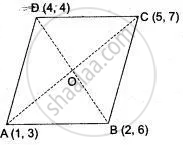Advertisements
Advertisements
प्रश्न
Show that the points A(1, 3), B(2, 6), C(5, 7) and D(4, 4) are the vertices of a rhombus.
= `a(1/t^2 + 1) = (a(t^2 + 1))/t^2`
Now `(1)/"SP" + (1)/"SQ" = (1)/(a(t^2 + 1)) + (1 xx t^2)/(a(t^2 + 1)`
= `((1 + t^2))/(a(t^2 + 1)`
`(1)/"SP" + (1)/"SQ" = (1)/a`.
उत्तर
To show that ABCD is a rhombus, it is sufficient to show that
(i) ABCD is a parallelogram i.e., AC and BD have the same mid point.
(ii) A pair of adjacent sides are equal.
Now, ,midpoint of AC = `((1 + 5)/2, (3 + 7)/2)`
= (3, 5).
Midpoint of BD = `((4 + 2)/2, (4 + 6)/2)`
= (3, 5).
Thus, ABCD is a parallelogram.
Also AB2 = (2 - 1)2 + (6 - 3)2
= 1 + 9 = 10 units.
BC2 = (5 - 2)2 + (7 - 6)2
= 9 + 1 = 10 units.
Therefore AB2 = BC2 ⇒ AB = BC
Hence, ABCD is a rhombus.
APPEARS IN
संबंधित प्रश्न
Calculate the co-ordinates of the point P which divides the line segment joining: A (1, 3) and B (5, 9) in the ratio 1 : 2
In what ratio is the line joining (2, –3) and (5, 6) divided by the x-axis?
In what ratio is the line joining (2, –4) and (–3, 6) divided by the y-axis?
Find the image of the point A(5,3) under reflection in the point P(-1,3).
Find the image of the point A(5,3) under reflection in the point P(-1,3).
Prove that the points A(-5, 4), B(-1, -2) and C(S, 2) are the vertices of an isosceles right-angled triangle. Find the coordinates of D so that ABCD is a square.
The line segment joining A (2, 3) and B (6, – 5) is intersected by the X axis at the point K. Write the ordinate of the point K. Hence find the ratio in which K divides AB.
If the line joining the points A(4, - 5) and B(4, 5) is divided by the point P such that `"AP"/"AB" = (2)/(5)`, find the coordinates of P.
The midpoint of the line segment AB shown in the diagram is (4, – 3). Write down the coordinates of A and B.
In the following figure line APB meets the X-axis at A, Y-axis at B. P is the point (4, -2) and AP: PB = 1: 2. Write down the coordinates of A and B.
